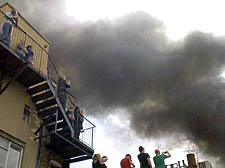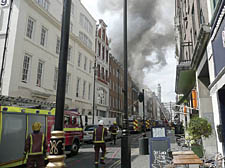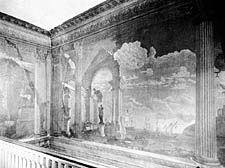|
|
 |
| |

Nearby residents take snaps of the fire on mobile phones and black smoke fills the afternoon sky |
Battle to save history in the walls of house hit by massive blaze
Fire Brigade probe cause of fire as heritage team attempt to preserve listed building’s mural
WHILE a fire investigation team sets to work establishing whether the rumoured fault in an air-conditioning duct was the cause of last Friday’s dramatic blaze on Dean Street in Soho, Westminster Council is overseeing an equally delicate operation.
With the help of English Heritage, a team of conservation workers are sifting through the burnt embers of Grade II-listed No 76 to try and salvage a rare and priceless wall mural that adorns the stairwell of the historic building.
The four-storey building used by finance firm Future Capital caught fire during the afternoon.
While the cause is still officially under investigation, the theory that the recently installed air conditioning duct overheated, is understood to be gaining credibility. But the Fire Brigade say the investigation could take a month because of the painstaking recovery work.
It is hoped that at least part of the striking 1730s classical sea scene, one of only two such murals in the whole of London, will be recovered. The expansive scene by an unknown artist is framed by two Corinthian columns, spaced out to depict views of classical ruins and seascapes, complete with crumbling arches, bronze statues, a giant battleship and a striking sun and cloud sky scene.
It is thought that the mural, which could be worth up to £500,000, was commissioned by former occupant John Hamilton, a naval officer who captained the Deal Castle in 1741 and the Kinsale in 1742. The building also boasts exquisite wood panelling, and is very much on the map of the capital’s historians, archivists and architects.
Rosemarie MacQueen, Westminster Council’s strategic director for built environment, said: “All the floors collapsed into the basement and, as well as the fire damage, a large amount of water was pumped into the building. But despite this we are hopeful that an original wall painting of a ship can be restored, and we have managed to rescue some fine wood panelling and parts of the main entrance hall and staircase.
“We are doing our utmost to ensure the facade of this beautiful building, and as many of its interior features as possible, are preserved. As a result the salvage operation will take longer than usual and regrettably access in the street will be limited while this is ongoing.
“In addition, by rescuing sections of cornicing and other original artefacts which have been damaged but not totally destroyed, we hope the building will eventually be able to be returned as closely to its original condition as possible.”
The house itself has a long and illustrious history, boasting a long entry in the Survey of London. Built by Thomas Richmond in 1735, the first occupant was the 7th Earl of Abercorn, a famous scientist and member of the Royal Society. In the early 19th century it housed Rundell Bridge & Rundell, one of the world’s most famous silversmith firms, before being rented by the church as an orphanage for poor children removed from the workhouses in nearby St Giles’s and Bloomsbury.
It took seven hours to put out the raging blaze, in which nobody was hurt and hundreds of workers were evacuated, although two firefighters did suffer minor injuries.
At its height more than 100 firefighters were tackling the flames that sent plumes of thick smoke across the West End, and turned Soho into a virtual blackout.
Its entire third floor and most of its second floor were damaged, as well as roof collapsed. Much of Dean Street has been paralysed since the blaze, with restaurants including the only recently reopened Quo Vadis, and the Soho Theatre
A Fire Brigade spokesman said the investigation was unlikely to discover the cause of the fire before the end of the month.

Fire engines are backed up down Dean Street |
Fire station was left ‘unmanned’
THE Dean Street blaze could have been tackled much faster if procedures to ensure there was a standby engine at Soho fire station were followed, the Fire Brigade Union has claimed.
When the fire broke out, all three engines and 10 firefighters from the station in Shaftesbury Avenue were attending another incident, leaving it unmanned and meaning the closest engines were in Knightsbridge and Euston.
The FBU has raised questions over why there was no cover at the station. Staff and equipment cuts in 2005 led to the closure of nearby Manchester Square First station, which would have been the next nearest station to the incident.
A spokesman for the London Fire Brigade said the standby procedures were a matter of judgment for an officer at the station. “There are lots of reasons why you wouldn’t put the standby procedure into operation. On Friday they were at an incident in Covent Garden that was over in half an hour. That’s why cover wasn’t called for,” he said.
Ian Leahair, FBU national executive member said: “The question that needs to be asked is why wasn’t there a cover engine at Soho. Whoever the officer of the day was must have thought they didn’t need one when they were called out on the other incident. The union’s position is that there is a moral obligation to have every station manned. The people of Soho pay their council tax and they should be able to rest assured that their local station is manned.”
The Dean Street fire was the third to strike the area in a matter of weeks. The day before the incident firefighters were called to a fire in a Chinatown restaurant, and a week earlier they tackled a shop fire in Denmark Street.
Tim Kyte, station manager at Soho fire Station, said: “With Dean Street, the main worry was the spread of the fire, and the crews did a fantastic job to stop it spreading. That fire was unusual in the way it spread. I’ve never seen a fire spread down before.”

The mural inside 76 Dean Street |
‘The Blitz!’ Resident’s view
76 DEAN Street is up the road from where I live at 68 and whenever I walk past it I always look in the windows to remind myself of its wonderful panelling and spectacular painted staircase. You can see the bottom of this painted staircase from the street. Last month I had a visit from Charles Brooking whose famous collection of iron and woodwork is turning into National Museum and we rang the doorbell and asked to have a look.
He was (as anyone would be) astonished at the staircase mural which is one of only two in London’s West End from the early 1700s.
Around 1.30pm last Friday there was a strong smell of burning and I went up to have look to see lots of fire engines arriving – I think about 11 of them and large crowds watching smoke pouring out of the building.
At around 3pm I and neighbours were evacuated, joining hundreds of onlookers, TV cameras and journalists in Old Compton Street watching vast billows of smoke and 30ft flames with bits of ash falling all around. It gave a tiny glimpse of what the Blitz must have been like.
The house was built by Thomas Richmond (hence Richmond Mews) in 1735 and the first occupant was the 7th Earl of Abercorn James Hamilton, a member of the Royal Society and scientist.
Its most notable feature is (was) probably the striking painted staircase which was a mixture of classical and sea scenes painted in the late 1730s by an unknown artist, unusually wide and impressive. The house has a very long entry in the Survey of London.
DAVID BIEDA
* |
 |
|
 |
| |
| |
|
 |
|